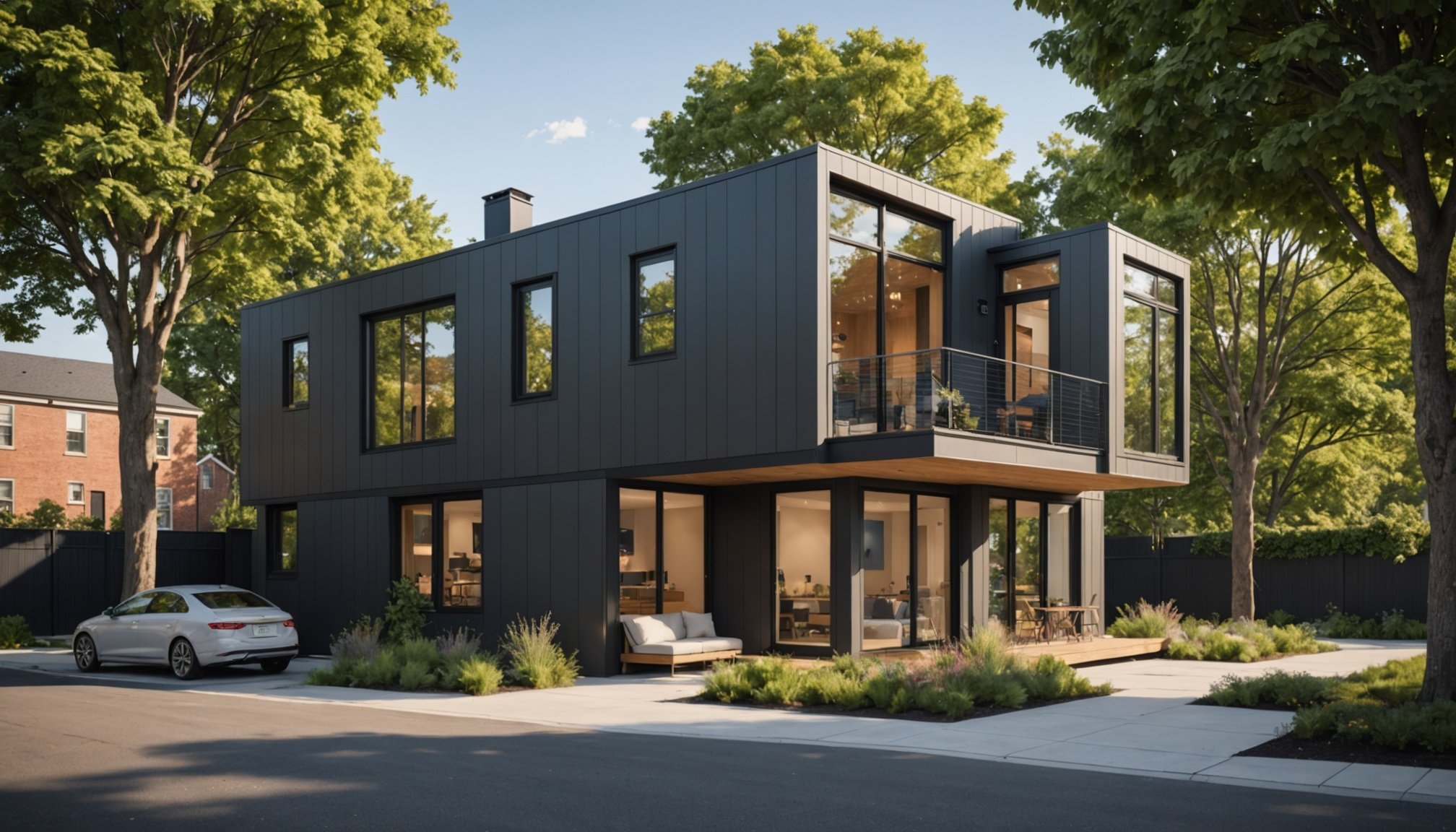Unpacking the Surge of Modular and Prefab Homes in Cityscapes: Essential Trends and Insights to Know
The Rise of Modular Construction: Why It’s Here to Stay
Modular construction, often referred to as prefabrication, is rapidly emerging as a transformative trend in the construction industry. This innovative approach involves assembling building components off-site in a controlled factory environment before transporting them to the site for final assembly. The reasons behind its growing popularity are multifaceted and compelling.
Speed and Efficiency
One of the most significant advantages of modular construction is its ability to reduce project timelines by 30-50%. This is achieved through simultaneous on-site and off-site work, making it ideal for urgent projects like healthcare facilities and schools. As Ravideep Singh, Associate Director at CDA, notes, “Modular construction in healthcare has seen up to 30% cost savings and 50% time savings,” highlighting the potential for even greater efficiencies as the technology matures[2].
Cost-Effectiveness
Lower labor costs and shorter timelines translate to significant savings. For instance, in New York City, modular construction is part of Mayor Bill de Blasio’s Housing New York 2.0 plan, aimed at reducing development time and cost, thereby increasing the efficiency of the city’s affordable housing investments[1].
Quality Control
The factory-controlled environment ensures consistent quality and precision. Nithin Hosabettu, Design Director at IMK Architects, emphasizes that “modular products are better valued and engineered, with more attention to detail, resulting in superior finishing and precision”[2].
Sustainability: A Key Driver in the Adoption of Modular Construction
Sustainability is at the core of modular construction, making it a key player in the future of green building.
Reduced Waste and Pollution
Modular construction reduces waste and promotes recycling, integrating energy-efficient materials to meet green building standards. Avinash Pai, Group Marketing Manager at Terraco, remarks, “Sustainability is at the core of modular construction, with its ability to integrate energy-efficient materials and reduce waste, making it a key player in the future of green building”[2].
Energy Efficiency
Modular buildings are designed with energy efficiency in mind, using materials and systems that minimize energy consumption. This approach not only reduces greenhouse gas (GHG) emissions but also helps in achieving net zero energy goals. For example, the use of high-quality insulation and energy-efficient windows can significantly lower the energy demand of a building.
Global Adoption and Market Trends
Modular construction is gaining momentum globally as the demand for efficient and sustainable building solutions increases.
Market Size and Growth
The modular construction market is valued at USD 90.80 billion in 2022 and is predicted to reach USD 151.31 billion by 2031 at a 5.9% CAGR. This growth is driven by rapid urbanization and industrialization in emerging economies, as well as government efforts to encourage sustainable architecture[3].
Regional Insights
- North America: The North American modular construction market is expected to register the highest market share in revenue, driven by increased demand from the residential and commercial sectors[3].
- Asia Pacific: This region is projected to grow rapidly, boosted by increasing population, more buildings, and a robust construction market. Countries like China are investing heavily in prefabricated technologies to keep pace with rapid urbanization[3].
- GCC Region: The GCC region is experiencing a significant rise in modular construction, driven by rapid urbanization and infrastructure demands. The modular construction market in the GCC reached $3.4 billion in 2023, with a 20% adoption rate in residential, healthcare, and hospitality sectors[2].
Case Studies: Real-World Applications of Modular Construction
Affordable Housing in New York City
In New York City, modular construction is being used to address the affordable housing crisis. For example, the 32-story modular apartment rental building at 461 Dean Street in Brooklyn is a prime example of how modular construction can deliver affordable housing quickly and efficiently. Jeffrey Jacobs, the sponsor of a condo project using modular construction, highlights the financial and quality benefits: “It made sense on many levels… financially, it shortened the construction period, lessening interest to the bank. Secondly, when building in a factory, you can control the quality of the workmanship much more easily without nature being involved”[1].
Healthcare Facilities
Modular construction is particularly beneficial for healthcare facilities due to the need for silence, safety, and cleanliness. Modular buildings can provide low-cost, high-quality, and aesthetically pleasing custom-built facilities. For instance, in countries like the US, Germany, the UK, China, and India, modular construction is being used to build medical, surgical, clinical, and dental facilities quickly and efficiently[3].
Technological Advancements and Digital Transformation
The integration of new technologies is further enhancing the benefits of modular construction.
Artificial Intelligence and Real-Time Data
The use of artificial intelligence (AI) and real-time data analytics is improving the design, manufacturing, and assembly processes of modular construction. AI can optimize the layout and design of modules, reduce material waste, and predict potential construction delays, thereby enhancing overall efficiency.
Energy Efficiency and Climate Action
Technologies such as building information modeling (BIM) and energy management systems are being integrated into modular construction to ensure energy efficiency and reduce carbon dioxide emissions. These technologies help in achieving long-term climate change mitigation goals by ensuring that buildings are designed and constructed with low carbon footprints.
Practical Insights and Actionable Advice
For those considering modular construction, here are some practical insights and actionable advice:
Planning and Design
- Early Planning: Involve modular construction experts early in the planning phase to ensure that the design is optimized for off-site manufacturing.
- Site Preparation: Simultaneously prepare the site while the modules are being manufactured to reduce overall project time.
Financial Considerations
- Cost Savings: Modular construction can offer significant cost savings due to reduced labor costs and shorter construction timelines.
- Financing Options: Explore financing options such as equity share and customized loan services to support your modular construction project[4].
Sustainability and Energy Efficiency
- Energy-Efficient Materials: Use energy-efficient materials and systems to minimize energy consumption and reduce GHG emissions.
- Waste Reduction: Implement recycling and waste reduction strategies during the construction process to align with green building standards.: Shaping the Future of Cityscapes
Modular construction is not just a trend; it is a new building paradigm that is here to stay. With its ability to reduce construction time, lower costs, ensure high-quality workmanship, and promote sustainability, it is an ideal solution for addressing the global housing needs and climate change challenges.
Key Trends to Watch
- Increased Adoption: Expect a significant increase in the adoption of modular construction across various sectors, including residential, healthcare, and hospitality.
- Technological Advancements: The integration of AI, BIM, and other digital technologies will continue to enhance the efficiency and sustainability of modular construction.
- Global Expansion: The modular construction market will expand globally, driven by government initiatives, urbanization, and the need for sustainable building solutions.
As Tom Hardiman, Executive Director of the Modular Building Institute, predicts, “Modular construction will become more mainstream in the next 2 to 3 years” due to the high infrastructure needs, low labor availability, and the need to embrace new technologies to improve productivity[1].
In conclusion, modular construction is a game-changer for the future of cityscapes, offering a sustainable, efficient, and cost-effective way to build. As we move forward, it is crucial to leverage these trends and insights to make informed decision-making and shape a more sustainable and resilient built environment.
Detailed Bullet Point List: Benefits of Modular Construction
-
Speed and Efficiency:
-
Reduces project timelines by 30-50%
-
Simultaneous on-site and off-site work
-
Ideal for urgent projects like healthcare facilities and schools
-
Cost-Effectiveness:
-
Lower labor costs
-
Shorter construction timelines
-
Significant cost savings (up to 30% in some cases)
-
Quality Control:
-
Factory-controlled environment ensures consistent quality and precision
-
Better valued and engineered products
-
Superior finishing and precision
-
Sustainability:
-
Reduces waste and promotes recycling
-
Integrates energy-efficient materials to meet green building standards
-
Minimizes energy consumption and reduces GHG emissions
-
Flexibility and Scalability:
-
Highly adaptable and easily modified or expanded
-
Can be relocated or repurposed
-
Ideal for rapidly changing environments
-
Safety and Health:
-
Reduces construction accidents
-
Eliminates weather days (work often takes place inside a factory)
-
Ensures silence, safety, and cleanliness in healthcare facilities
Comprehensive Table: Comparison of Modular and Traditional Construction
| Criteria | Modular Construction | Traditional Construction |
|---|---|---|
| Time | 30-50% reduction in project timelines | Longer construction timelines |
| Cost | Lower labor costs, significant cost savings | Higher labor costs, potential cost overruns |
| Quality | Consistent quality and precision in a factory-controlled environment | Variable quality dependent on site conditions |
| Waste | Reduced waste and promotion of recycling | Higher material waste |
| Energy Efficiency | Integration of energy-efficient materials and systems | Variable energy efficiency depending on design and materials |
| Flexibility | Highly adaptable and easily modified or expanded | Less adaptable and more difficult to modify |
| Safety | Reduced construction accidents, elimination of weather days | Higher risk of construction accidents, weather-related delays |
| Environmental Impact | Minimized energy consumption, reduced GHG emissions | Higher energy consumption, increased GHG emissions |
This table highlights the key differences between modular and traditional construction methods, emphasizing the advantages of modular construction in terms of time, cost, quality, waste reduction, energy efficiency, flexibility, safety, and environmental impact.











